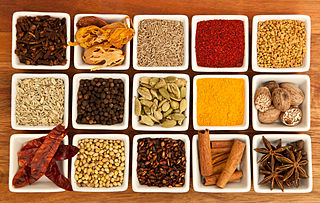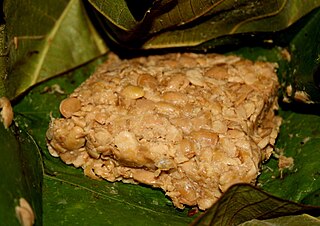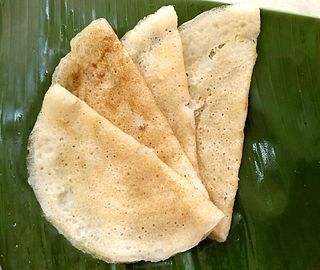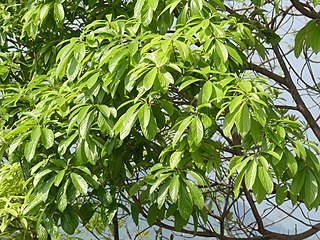
Chhaang or chhyang is a Nepalese and Tibetan alcoholic beverage also popular in parts of the eastern Himalayas, Yakkha, Limbu, Dura, Newar, Sunuwar, Rai, Gurung, Magar, Sherpa, Tamang and Lepcha communities. Among the Lepcha, it is called Chi. It is also known as jaarh in Nepal.

Mishti doi or Mitha Dahi is a fermented sweet dahi (yogurt) originating from the Bogra District in Bangladesh and is a very popular dessert throughout the country. It is also consumed in the Indian states of Assam, Odisha, Tripura and West Bengal, with similar dishes branching off of it such as the Nabadwip-er lal doi of Kolkata. It is made with milk and sugar or jaggery. It differs from the plain yogurt because of the technique of preparation. There are many variations of mishti doi according to their popularity.

Tongba is a millet-based alcoholic beverage found in the eastern mountainous region of Nepal and neighbouring Indian regions of Sikkim and Darjeeling. It is the traditional drink of the Limbu people as well as people of other Kirati communities and many other ethnic group of Nepal. Tongba is culturally and religiously important to the Limbus; offering it is a sign of respect to a guest, and the drink is also an important element of special occasions and festivals.
A fermentation starter is a preparation to assist the beginning of the fermentation process in preparation of various foods and alcoholic drinks. Food groups where they are used include breads, especially sourdough bread, and cheese. A starter culture is a microbiological culture which actually performs fermentation. These starters usually consist of a cultivation medium, such as grains, seeds, or nutrient liquids that have been well colonized by the microorganisms used for the fermentation.

In the cuisine of Sikkim, in northeastern India, rice is a staple food, and fermented foods traditionally constitute a significant portion of the cuisine. Nepalese cuisine is popular, as Sikkim is the only state of India with an ethnic Nepali majority. Many restaurants in Sikkim serve various types of Nepalese cuisine, such as the Limbu, Newa and Thakali cuisines. Tibetan cuisine has also influenced Sikkimese cuisine. The combination of various cuisines has resulted in one specific cuisine.

Sinki is a Nepali preserved fermented vegetable, similar to gundruk. Gundruk is prepared from leafy vegetables but sinki is prepared from radish tap roots.

Kinema is a fermented soybean food, prepared by the Nepali communities of the Eastern Himalayas region: Eastern Nepal, and Darjeeling, Kalimpong and Sikkim regions of India. Kinema is a traditional food of the Limbu people, as well as people of other Kirati communities.

Chakuli pitha is a flat Odia rice-based fermented cake traditionally popular in the regions of Odisha in India. It is prepared and served during festivals.

Handvo is a savory vegetable cake originating from Gujarat, India. It is a part of the Gujarati cuisine. It is often made with a bottle gourd filling, though many other vegetables can be added. Sometimes crushed peanuts are also added.
Sulai is a rectified spirit brewed in the Northeast Indian state of Assam. A clear, colourless alcohol, Sulai is known as tharra in north India, handia or pheni in Nepal, and referred to as country liquor in colloquial parlance. It is generally brewed from fermented molasses or occasionally rice.

Nuruk (누룩) is a traditional Korean fermentation starter. It is used to make various types of Korean alcoholic beverages including takju, cheongju, and soju. It is an essential ingredient in Shindari and is mixed with rice. Historically, it was used in a variety of provinces of Korea, including Jeju Island.

Phoebe hainesiana is a species of tree in the family Lauraceae, native to India. It is the state tree of Manipur.

Baechu-kimchi (배추김치), translated as cabbage kimchi or simply kimchi is a quintessential banchan in Korean cuisine, made with salted, seasoned, and fermented napa cabbages.
Professor Dr. Jyoti Prakash Tamang is an Indian food microbiologist, working on fermented foods and alcoholic beverages of the Himalayan regions of India, Nepal and Bhutan and South East Asia for last 36 years and the Senior Professor in Microbiology of the Sikkim Central University. Known for his studies on fermented food, Prof. Tamang is an elected fellow of the Indian National Science Academy (FNA), National Academy of Science, India (NASI),National Academy of Agricultural Sciences, Indian Academy of Microbiological Sciences and the Biotech Research Society of India. The Department of Biotechnology of the Government of India awarded him the National Bioscience Award for Career Development, one of the highest Indian science awards, for his contributions to biosciences in 2004, and International Centre for Integrated Mountain Development (ICIMOD)-Mountain Chair (2019-2022). Prof. Tamang was nominated as Global Kimchi Ambassador by World Institute of Kimchi of Government of South Korea.
Alcohol is Legal to produce 60 Litres of fermented beverage and distill 30 Litres Raksi per year for personal consumption, but it's illegal to sell home made Spirits Raksi in Nepal. The mixed society, coupled with caste and multiple ethnic results in extremely complex social behaviour. Based on the caste and religion, there are two types of people in Nepal depending upon alcohol uses. The group of people who do not drink or use alcohol are called Tagadhari (तगाधारी), and the other group who drink alcohol are called Matawali. Generally, the Brahmins and Kshatriyas are the Janai wearer and do not drink alcohol, but with the exception of Matwali Chhetries of Karnali who are permitted to use alcohol. Matwali uses alcohol for their traditional purposes and generally brew alcohol by themselves. People such as Kirati people, Magar, Gurung, Tamang, Newars use alcohol freely.
Hentak is a thick fermented paste in Manipuri cuisine made with sun-dried fish powder and the petioles of aroid plants. The small Indian flying barb fish are sun dried on bamboo trays and crushed to powder. The aroid petioles are cut into pieces and left in the sun for one day, then in equal parts with the fish powder the mixture is sealed in an earthen pot and fermented for around one week.

Sra peang is a rice wine stored in earthen pots and indigenous to several ethnic groups in Cambodia, in areas such as Mondulkiri or Ratanakiri. It is made of fermented glutinous rice mixed with several kinds of local herbs. The types and amount of herbs added differ according to ethnic group and region. This mixture is then put into a large earthenware jug, covered, and allowed to ferment for at least one month. The strength of this alcoholic beverage is typically 15 to 25 percent alcohol by volume.